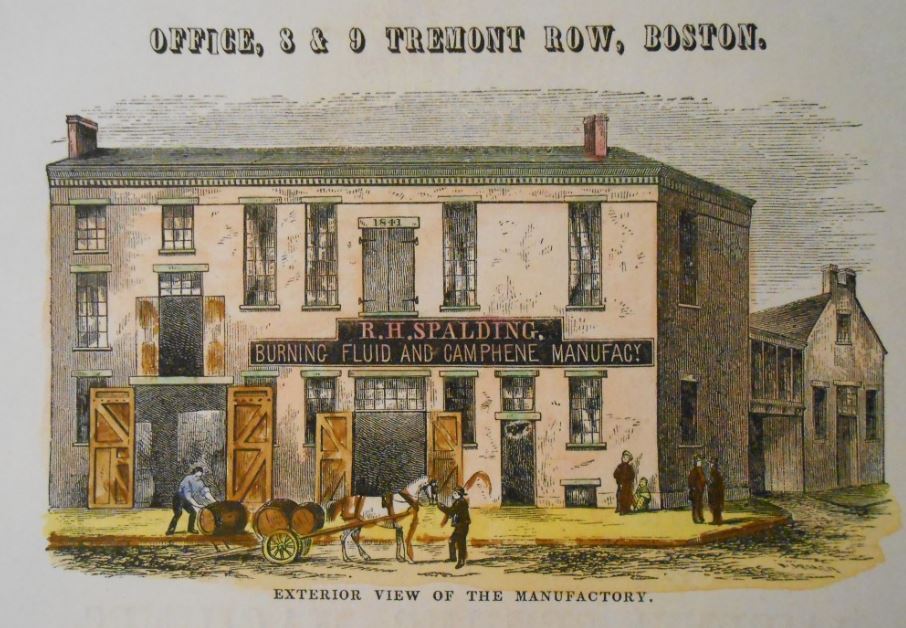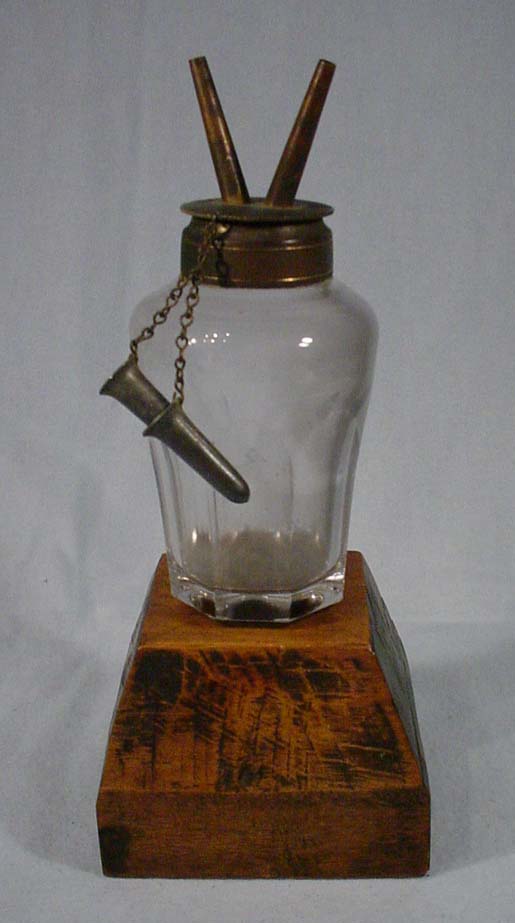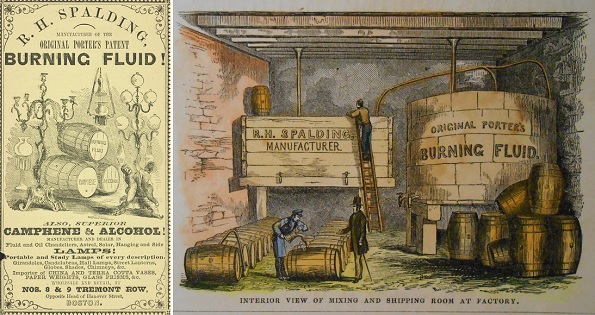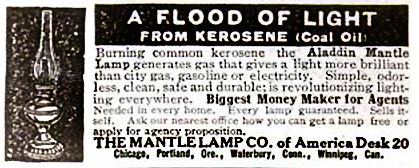Camphene and popular but risky burning fluid are replaced by a brighter, less volatile lamp fuel.
In the early 19th century, lamp designs burned many different fuels, including rapeseed oil, lard, and whale oil rendered from whale blubber (and the more expensive spermaceti from the heads of sperm whales), but most Americans could only afford light emitted by animal-fat, tallow candles.
By 1850, the U.S. Patent Office recorded almost 250 different patents for all manner of lamps, wicks, burners, and fuels to meet growing consumer demand for illumination. At the time, most Americans lived in almost complete darkness when the sun went down.

The Boston company of Rufus H. Spalding manufactured burning fluid and camphene as inexpensive illuminating fuels while promoting “portable and steady lamps of every description.”
Up to 1840, whale oil was the most popular lamp fuel. Subsequently, lamp fuels included lard oil and turpentine mixtures, as well as camphene, a term coined by Augustus Webb of New York in his 1838 patent for a lamp burning distilled spirits of turpentine.
Camphene, the distilled spirits of turpentine used as a lamp fuel, produced an inexpensive and bright light, but required a chimney or draft system to adequately produce combustion without smoking.
In 1835, Henry Porter of Bangor, Maine, patented his camphene mixture and opened a business to sell it in downtown Boston, Massachusetts. The concoction combined one part turpentine with four parts alcohol, and a small amount of camphor for aroma.
“Porter’s Burning Fluid” became a popular lamp fuel. It burned brightly and smelled good, but could be dangerous, the Boston Mattapan Register reported, explaining that house fires and injuries were too common.
The burning fluid lamp was simple, requiring only a burner with a narrow tube or tubes to hold the wick — and no chimney, according to Charles Leib, publications chairman, The Rushlight Club, an international association of collectors and students of historic lighting.
The alcohol mixture used, however, contained highly volatile vapors, Leib added, noting, “The burning fluid lamps were prone to mishandling, especially when filling, resulting in “flash fires” when escaping vapors from the burning fluid lamp came in contact with an existing flame or fire.”

Before kerosene, two-wicked “burning fluid” lamps were popular but sometimes dangerous sources of light.
The Boston newspaper noted on September 10, 1859:
There are different kinds of lamps and of lamp oil, adapted to different tastes and circumstances; and there is one at least, most abominable invention under the name of Camphene Oil, or Burning Fluid, which were better denominated a Swift and Ready Means of Destruction for Private Families; for this designation would convey a true idea of its nature and effects.
This was a common misstatement, putting together camphene and burning fluid as the same product, according to Leib. “During the popularity of burning fluid lamps in the 1850s, numerous patents for safety features were issued to solve these problems,” explained the author of “Did You Mean Camphene or Burning Fluid?” in The Bulletin, (pages 28-37), Winter 2011, of the Pewter Collectors’ Club of America.
Despite the perceived risks, consumer demand for camphene and burning fluids grew. By 1856, Rufus H. Spalding had taken over Henry Porter’s Boston business as the “Sole Manufacturer of Porter’s Patent Composition.”

Circa 1855 advertisements for “Original Porter’s Patent Burning Fluid, Superior Camphene & Alcohol” manufactured by Rufus H. Spalding.
Spalding offered many ornamental lighting devices, including girandoles and candelabra, along with lanterns and lamps for all kinds of fuels (also see Making a Two-Wick Camphene Lamp).
Spalding’s downtown Tremont Row offices and “manufactory” on Adams Street supplied camphene to Boston’s expanding population.
Whale Oil, Rock Oil, and Gaslight
The cost of whale oil ranged from $1.30 a gallon to $2.50 a gallon ($46.61 a gallon to $93.47 a gallon in 2024 dollars). Lard oil was about 90 cents a gallon. More popular was the manufactured “coal oil,” a fuel refined from coal that cost about 50 cents a gallon, but it was sooty and yielded a low quality light.
Rock oil had been patented in 1854 by a Canadian physician and geologist, Abraham Gesner, who named his lamp fuel kerosene. Most people called it coal oil. A factory in Long Island, New York, soon began producing and selling Gesner’s new product.
In larger cities, public street gaslights already burned a “manufactured gas” made by distilling tar and wood. Baltimore, Maryland, lit the first U.S. public gas street lamp in 1817 at a ceremony one block from city hall.
In 1836, the newly formed Philadelphia Gas Works operated a “gasification” plant that manufactured illuminating gaslight from refined coal that was piped to 46 street lamps.
But for cheap, bright household lighting, many Americans still bought a two-wick lamp fueled with camphene. The unusual lamps had burners with long wick tubes set at angles to burn separately, a design many believed helped lower the risk of “flash fires.” Metal caps were placed over the tubes to extinguish the flames (considered safer than blowing them out).
 Alcohol used in camphene was an important mainstay for distilleries, with many selling 30 percent to 80 percent of their output to the lamp fuel market. Taverns aside, by 1860 distilleries were delivering at least 90 million gallons of alcohol per year to the lighting industry.
Alcohol used in camphene was an important mainstay for distilleries, with many selling 30 percent to 80 percent of their output to the lamp fuel market. Taverns aside, by 1860 distilleries were delivering at least 90 million gallons of alcohol per year to the lighting industry.
Camphene and a variety of burning fluid production and distribution systems were well established and, with whale oil becoming increasingly expensive, the future looked bright, despite the occasional flash fires. Then, on August 27, 1859, Edwin L. Drake drilled America’s first commercial oil well in Titusville, Pennsylvania.
Investors in “Drake’s Folly,” including George Bissell of the Seneca Oil Company of New Haven, Connecticut, learned from a Yale professor that oil could be refined into kerosene. Simple distillation of oil yielded kerosene that sold for about 50 cents a gallon, about the same price as camphene. Pennsylvania refineries sprang up using basic “tea kettle” stills with 40 gallons to 4,000 gallons per day capacity.
As inexpensive oil-based kerosene began overwhelming makers of camphene (and coal oil) at the start of the Civil War, a tax on alcohol extinguished the camphene lighting business along with the other burning fluids..
To help fund the Union Army, the Internal Revenue Act imposed a $2.08 per gallon tax on alcohol between 1862 and 1864. Intended as an excise tax on beverage alcohol only, the law did not specifically exempt industrial uses, including camphene, which was about 75 percent high-proof alcohol.

According to a February 2022 article in Environmental History, “the U.S. government created the oil industry with a federal tax on fuels that had already been in competition with whale oil, especially alcohol, which was a necessary ingredient in camphene and burning fluids.”
Camphene, once favored, was soon forgotten in American households (Congress repealed the alcohol tax in 1906).
Kerosene fuels Petroleum Industry
Today the home of an oil museum and park, the Drake well yielded hundreds of gallons of high-quality crude oil. Each gallon could be distilled into about three quarts of lamp fuel. The new product became interchangeably known as rock oil, coal oil, carbon oil, or kerosene (the 19th-century product is still used as rocket fuel).

An ad seeking agents to sell Aladdin brand of kerosene lamps, circa 1900.
Following Drake’s 1859 historic discovery, Samuel Kier of Pittsburgh was his first customer – and the first person in the United States to refine oil for lamp fuel. He sold his higher quality “Carbon Oil” at $1.50 per gallon.
After a drilling slowdown during the Civil War, the first oil boom towns appeared in northwestern Pennsylvania. Barges began moving 42-gallon oil barrels down Oil Creek to the Allegheny River and onto newly built refineries in Pittsburgh. Wooden derricks appeared, many with two-wicked oilfield lanterns called yellow dogs fueled with crude oil.
Within a few years, kerosene lamps illuminated almost every American home. Many new exploration and production companies prospered thanks to kerosene. Then, beginning in the 1880s, kerosene for lamps started to become obsolete as a new technology entered the marketplace.

Thomas Edison’s electric lights steadily began to replace kerosene lamps. Almost as quickly as kerosene extinguished camphene 20 years before, electric lighting dimmed kerosene’s future as consumers switched on electric lights. The loss of its principal product could have doomed America’s young petroleum industry.
Then, another radical invention became incredibly popular with consumers, not for lighting, but for transportation. “Horseless carriages” with internal combustion engines fueled by a petroleum product provided a new opportunity for the oil business (see Cantankerous Combustion – 1st U.S. Auto Show).
With diminishing demand for kerosene, demand for gasoline transformed America’s oil exploration, production, and transportation companies. Consumer demand for a formerly discarded by-product of kerosene distillation came at an especially good time for Texas wildcatters.
In 1901, the giant Spindletop Hill oilfield was discovered near Beaumont. The modern petroleum age arrived.
_______________________
Recommended Reading: Oil Lamps The Kerosene Era In North America (1978); Myth, Legend, Reality: Edwin Laurentine Drake and the Early Oil Industry
(2009). Your Amazon purchase benefits the American Oil & Gas Historical Society. As an Amazon Associate, AOGHS earns a commission from qualifying purchases.
_______________________
The American Oil & Gas Historical Society (AOGHS) preserves U.S. petroleum history. Become an AOGHS annual supporting member and help maintain this energy education website and expand historical research. For more information, contact bawells@aoghs.org. Copyright © 2024 Bruce A. Wells. All rights reserved.
Citation Information – Article Title: “Camphene to Kerosene Lamps.” Authors: B.A. Wells and K.L. Wells. Website Name: American Oil & Gas Historical Society. URL: https://aoghs.org/products/camphene-to-kerosene-lamps. Last Updated: December 14, 2024. Original Published Date: April 29, 2017.



